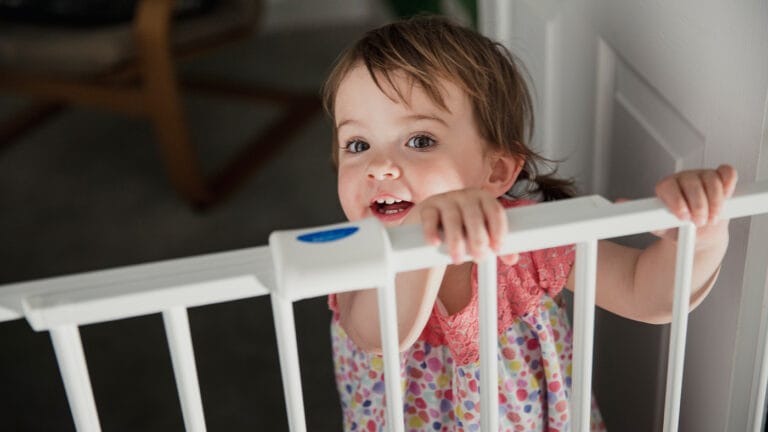Hopping in the car is a daily adventure as you take your child out and about for everyday activities like school drop-offs, errands, and trips to the park. While we don’t always consider the risks, riding in the car is one of the most dangerous things your child does on any given day. The first line of defense is ensuring your most precious cargo is secure with an appropriate and correctly installed car seat. However, there are common car seat mistakes that many parents may not be aware of, and avoiding them is crucial for your child’s safety.
Standard automobile seats are designed for full-sized bodies and aren’t intended for newborns, toddlers, or children. A car seat bridges the gap between tiny bodies and full-sized seats, transforming the conventional backseat setup into one that can keep your child safe on the road, but only when used correctly. Baby car seat mistakes can compromise this safety, so it’s important to know what to avoid.
The U.S. Department of Transportation’s National Highway Traffic Safety Administration (NHTSA) notes that about half (46%) of all car seats are installed incorrectly. Common errors range from minor to potentially fatal, and all of them reduce a car seat’s ability to keep your child safe in the event of a crash. Avoid these common mistakes to keep your little one(s) safe on the road.
1. Loose Car Seat
Step one to correctly installing a car seat is ensuring it is securely fastened. Typically, rear-facing and forward-facing car seats are secured using your car’s seat belts. Pass the seat belt through the designated slot, ensure no twists in the straps, and then buckle. Once buckled, pull the seat belt tight so the car seat is secured snuggly against the upholstery. Once installed, the car seat shouldn’t move more than an inch forward, back, or side to side.
2. Chest Clip Positioned Incorrectly
A car seat harness serves two main functions. First, it keeps your little one from moving around too much and getting into trouble. Second, it reduces and redistributes crash forces to the strongest parts of your child’s body. The chest clip should be centered over your child’s chest and level with their armpits. If incorrectly situated, the straps could cause an injury during an accident or fall off the shoulder and fail to protect your child.
3. Shoulder Straps at the Wrong Height
Much like the chest clip, shoulder straps must be correctly positioned to do their job. As part of the car seat harness, shoulder straps come through the back of the car seat at the top, falling over your child’s shoulders. The position of the straps will change as your child grows and changes car seats. In a rear-facing seat (intended for babies and infants), the shoulder straps should be at or below your child’s shoulders. In a forward-facing seat (intended for older kids), shoulder straps should be at or above the shoulders.
4. Harness Straps are Too Loose
Even if the car seat is correctly installed, the straps are at the right height, and the chest clip is correctly positioned, it will only do its job if the straps are tight enough. Straps should be pulled tightly against the body with little to no give, but not so tight that it causes pain or discomfort.
Do the pinch test: once your kiddo is strapped into their car seat, grab a strap and attempt to pinch it vertically with your thumb and forefinger. If you can pinch the fabric together, it’s too loose, but if it slips out of your grasp before it comes together, it’s just right.
5. Car Seat at the Wrong Angle
Adults have the luxury of adjusting their seat angle depending on personal preference, but babies aren’t so lucky. Newborns, in particular, haven’t yet developed the muscle strength to hold up their heads reliably, and they need to be supported even when being chauffeured around. A car seat will typically position your baby at an angle between 30 and 45 degrees, forward enough to protect them during an accident but not so forward that their airway is restricted.
Many car seats have an angle indicator that works like a level to help you find the right orientation. Make sure to install the car seat on level ground so that the angle indicator provides accurate readings. Recheck the angle periodically to correct for any shifting and make the necessary adjustments as your baby grows.
6. Car Seat Location in Vehicle
When it comes to car seat safety, not all locations are created equally. The general wisdom is that the back, center seat is the best possible spot. It’s farthest from everything else in the car, minimizing the impact risk during an accident. The rear passenger seat is also popular because it provides caregivers easy access, especially when entering and exiting busy streets.
If you have an older child who uses a booster seat, the middle may not be appropriate, as some cars don’t have shoulder straps in the middle seat. Additionally, if you’ve got multiple kids in car seats simultaneously, having one seat on either side might make more sense. All things being equal, go for the center seat in the back.
7. The Wrong Type or Size Car Seat
As children grow and their bodies change, so do their safety needs when riding in the car. Rear-facing seats are typically intended for newborns and infants; they work by cradling the baby in a slightly upright position and redirecting crash forces away from the neck and spine. Children should remain rear-facing until they reach the maximum height or weight limit set by the car seat manufacturer, which is typically two to three years old. Forward-facing seats are similar but are intended for slightly older kids. Both are strapped to the seat with the seatbelt and use their own harness systems to secure your child.
A booster seat, by contrast, relies on the conventional seat belt but boosts your child to a higher position so that the seat belt falls across their body in the right places. There are convertible and all-in-one car seats that will transition with your child as they grow. Your baby’s body will change over time, and their car seat needs to change with them.
8. Straps Needing Adjustment
When used correctly, car seat straps limit movement during a crash and protect against crash forces. They are designed to redistribute the impact of a car crash to more robust parts of the body, primarily the hips and shoulders. When straps aren’t adjusted correctly, your child is at increased risk of injury or ejection during a crash.
Kids grow, and they grow fast. It’s important to remember that straps that are correctly positioned today may need to be correctly positioned tomorrow or the next day. Refer to the guidance above and manufacturer instructions, and inspect and adjust the straps periodically to ensure proper placement as your child grows.
9. When Using an Older Car Seat
There are things that were made better in the past than they are today, but car seats aren’t one of those things. Safety standards have changed pretty dramatically over the last several decades, and they are changing all the time based on new information. A car seat built a decade ago or more probably doesn’t meet current safety standards.
Additionally, car seat materials wear down over time and may not be as effective at keeping your little one safe as they used to be. If your car seat has been around for over a couple of Olympic competitions, it’s probably about time to retire.
10. Not Registering Your Car Seat and Watching For Recalls
Registering your car seat is the most reliable way to ensure you are informed of any important alerts or product recalls. To register your car seat, you’ll need the model number, the date of manufacture, and information found on the seat label. You can register most car seats online or with a postage-paid card included in the packaging. You can also find information about recalls from the NHTSA website.
11. Keeping a Car Seat After an Accident
If your child’s car seat has gone through a crash, you can probably consider its career ended. The NHTSA says it may be safe to continue using a car seat after an accident if all of the following are true:
- The crash was minor, with no significant damage
- The vehicle could drive away from the accident
- There were no injuries
- Airbags didn’t deploy
- There is no damage to the door nearest the car seat
- There is no visible damage to the car seat
If the crash included any of the above components, it’s considered a moderate or severe accident, and you should assume the car seat was damaged. Thank it for a job well done, and replace it.
12. Using an Expired Car Seat
You might be surprised to learn that car seats have expiration dates, just like a carton of milk. Over time, through use and exposure to the elements, car seat components break down and become less safe. They are often left in cars for extended periods, exposed to extreme seasonal temperatures that break down plastics and other materials.
Generally, car seats are good for 6 to 10 years after the manufacture date. Lifespan may differ from seat to seat, but you can usually find the expiration date on the bottom of the seat or stamped into the plastic frame. If there isn’t, stick with the short end of the range and replace the seat after six years.
13. Wearing Bulky Clothes
Parents are more likely to wrap their little ones up in layers to keep them warm when it’s cold out. That bulky winter coat might protect your baby from the elements but not from a crash. A winter coat or other bulky clothes may create a compressible barrier between your baby and the car seat harness, leaving them vulnerable in the event of a crash.
When in doubt, do this test: strap your child into their seat while wearing their coat or other bulky clothes. Adjust and tighten the straps as you normally would, then remove the bulky clothes and strap them in again without adjusting the straps. If you can pinch the strap between your thumb and forefinger, the straps are too loose. And if they are too loose without the coat, they are too loose with it. If you’re worried about your little one being too cold, give them a blanket or drape the coat over them after they are strapped in.
14. Providing Hard Toys in the Car
Toys can be a great way to entertain your little one during trips in the car, but they can become dangerous projectiles during an accident. Avoid giving your little ones toys made of hard materials, which could become unsafe at high speed. Instead, look for toys that are soft and lightweight. If you wouldn’t want the toy thrown at your child, it’s probably not a good fit for the car.
15. Not Having Your Car Seat Inspected
At the beginning of this, we told you that nearly 50% of all car seats are installed incorrectly and are, therefore, less effective. If you’re not comfortable leaving your child’s safety up to a coin toss, an inspection from a certified car seat technician can put your worries to bed.
A technician will identify and correct any installation problems. Even if you are in the half of parents who did everything right, a technician can provide additional insight into your vehicle or family situation, which could optimize safety for everyone in your car. Certified technicians will usually check your car seat free of charge, and you can find an inspection site in your area using the lookup tool on the NHTSA website. It’s the only surefire way to make sure your little one is as safe as possible while you travel the wide world together.





